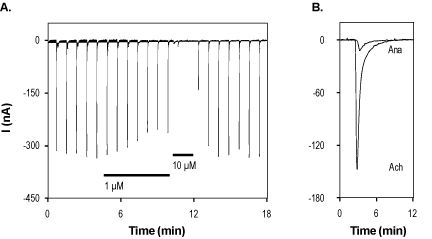Overview
Cat #:
D-110
Alternative Name 3-(4)-Dimethylaminobenzylidine anabaseine
Lyophilized Powder yes
Source Synthetic
MW: 364.3
Purity: >98%
Effective concentration 0.1-10 µM.
Chemical name 4-[(5,6-Dihydro[2,3'-bipyridin]-3(4H)-ylidene)methyl]-N,N-dimethylbenzenamine dihydrochloride.
Molecular formula C19H21N3*2HCl.
CAS No.: 154149-38-9
Activity DMAB-anabaseine dihydrochloride is a partial agonist of α7 nicotinic acetylcholine receptors (nAChR) and antagonist of α4/β2 nAChR1. It blocks the acetylcholine induced α7 current with IC50 ~5 µM2. DMAB-anabaseine dihydrochloride can also displace isotopic (-)-cytisine and α-bungarotoxin binding to rat brain membranes with high affinity3.
References-Activity
- Kem, W.R. et al. (1997) J. Pharmacol. Exp. Therap. 283, 979.
- Weltzin, M.M. et al. (2010) J. Pharmacol. 334, 917.
- de Fiebre, C.M. et al. (1995) Mol. Pharmacol. 47, 164.
Shipping and storage Shipped at room temperature. Product as supplied can be stored intact at room temperature for several weeks. For longer periods, it should be stored at -20°C.
Solubility Any aqueous buffer. Centrifuge all product preparations before use (10000 x g 5 min).
Storage of solutions Up to one week at 4°C or six months at -20°C.
Our bioassay
 Alomone Labs DMAB-anabaseine dihydrochloride inhibits α7 nicotinic acetylcholine receptors heterologously expressed in Xenopus oocytes.A. Current traces of α7 nicotinic acetylcholine receptor activity at -60 mV holding potential. Currents were elicited by application of 100 µM acetylcholine every 50 seconds. Inhibition of these induced currents was achieved upon perfusion of 1 or 10 µM DMAB-anabaseine dihydrochloride (#D-110) (indicated by horizontal bars). B. Superimposed current responses to the application of either 100 µM acetylcholine (Ach) or 100 µM DMAB-anabaseine dihydrochloride (Ana), demonstrating the partial agonist effect on α7 channels.
Alomone Labs DMAB-anabaseine dihydrochloride inhibits α7 nicotinic acetylcholine receptors heterologously expressed in Xenopus oocytes.A. Current traces of α7 nicotinic acetylcholine receptor activity at -60 mV holding potential. Currents were elicited by application of 100 µM acetylcholine every 50 seconds. Inhibition of these induced currents was achieved upon perfusion of 1 or 10 µM DMAB-anabaseine dihydrochloride (#D-110) (indicated by horizontal bars). B. Superimposed current responses to the application of either 100 µM acetylcholine (Ach) or 100 µM DMAB-anabaseine dihydrochloride (Ana), demonstrating the partial agonist effect on α7 channels.
References - Scientific background
- Kombo, D.C. et al. (2011) Eur. J. Med. Chem. 46, 5625.
- Papke, R.L. et al. (1994) Giacobini E, Becker R (eds) Alzheimer disease: therapeutic strategies, 206.
- de Fiebre, C.M. et al. (1995) Mol. Pharmacol. 47, 164.
- Kem, W.R. et al. (1997) J. Pharmacol. Exp. Therap. 283, 979.
- Stevens, K.E. et al. (1998) Psychopharmacology 136, 320.
- Weltzin, M.M. et al. (2010) J. Pharmacol. 334, 917.
Scientific background
nAChRs are members of the Cys-loop ligand-gated ion channel superfamily, located both in the peripheral and central nervous systems (PNS and CNS, respectively). These receptors, existing as both homopentameric and heteropentameric transmembrane ion channels, are validated therapeutic targets for various CNS pathologies1.
DMAB-anabaseine (DMAB), an anabaseine analog, is a selectively partial agonist at α7 receptors which are predominantly found in the CNS2,3. In contrast, DMAB is an antagonist at α3β4, α4β2 and other nicotinic receptors4,5 and blocks the α4β2 current with IC50 ~5 µM6.
Target nAChR
Lyophilized Powder
DMAB-anabaseine dihydrochloride (#D-110) is a highly pure, synthetic, and biologically active compound.
For research purposes only, not for human use
Last Update: 08/01/2025
Applications
Citations
Citations

